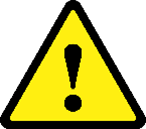
Do you know your safety signs?
Safety signs must be provided if there is a significant risk that cannot otherwise be controlled. What are the different types of signs and what do you need to know about them?
Why are signs needed?
It is important to use signage and labels in order to maintain health & safety standards, and to inform, educate, and protect people. By using a sign, the safety message is conveyed to everyone in a diverse workplace, regardless of language barriers.
Tip. The presence of safety signs does not have to be compulsory if they will not reduce the risk, or if it is not significant. However, some fire safety signs may be required to be displayed under separate legal provisions.
When and where to use signs?
Your risk assessments should specify the locations where signage is required. According to the Health and Safety (Safety Signs and Signals) Regulations of 1996, safety signs cannot take the place of other risk-reduction strategies. They must notify staff members of any substantial dangers that still exist or provide instructions on the protective actions they should take.
Tip. Avoid overusing signs as they begin to lose their usefulness. In the visual messages you convey, be clear and concise.
The Four Basic Signs
 The prohibition symbols, such as “No Smoking,” provide information about dangerous behaviour/activities. It has a round form, and either a white backdrop with a black symbol on it, or a red border with a red diagonal line.
The prohibition symbols, such as “No Smoking,” provide information about dangerous behaviour/activities. It has a round form, and either a white backdrop with a black symbol on it, or a red border with a red diagonal line.
 A warning sign advises you to exercise caution, take safety measures, and warns of potential dangers. It has a triangle-shaped design, a black pictogram with a yellow background and a black border. e.g. ‘Wet Floor’
A warning sign advises you to exercise caution, take safety measures, and warns of potential dangers. It has a triangle-shaped design, a black pictogram with a yellow background and a black border. e.g. ‘Wet Floor’
 A mandatory sign informs you about a specific behaviour or action. It is always round in shape with a white pictogram on a blue background, e.g. ‘PPE.
A mandatory sign informs you about a specific behaviour or action. It is always round in shape with a white pictogram on a blue background, e.g. ‘PPE.
 ’Safety locations, such as fire exits, are shown on emergency signs. With a white symbol on a green backdrop, they are either rectangular or square in shape.
’Safety locations, such as fire exits, are shown on emergency signs. With a white symbol on a green backdrop, they are either rectangular or square in shape.
Tip. You may need to provide other communication channels for visually challenged staff members, including audible directions/instructions during a fire evacuation.
Additional signs
The following are two additional types of signage to understand:
- Fire Signage – a red square with a white symbol, or white symbol with text in the middle, e.g. ‘Call Points’
- Global harmonised system – A red diamond with black symbols on a white backdrop to indicate a chemical’s classification (toxic, corrosive, etc.)
Good practice
Make sure all signs are clear and not faded and replace any signs that are defective right away. Ensure your workforce understands what they mean. Even though the majority of safety signs are self-explanatory, new, young, or inexperienced staff may not be familiar with them. Any sign’s meaning must be made clear, and workers must be made aware of the repercussions of disobeying the warning or instruction provided by the sign.
Contact Safety Aide on 08000 806 801 for any signage requests as we provide a wide range to suit the industry at competitive prices.

